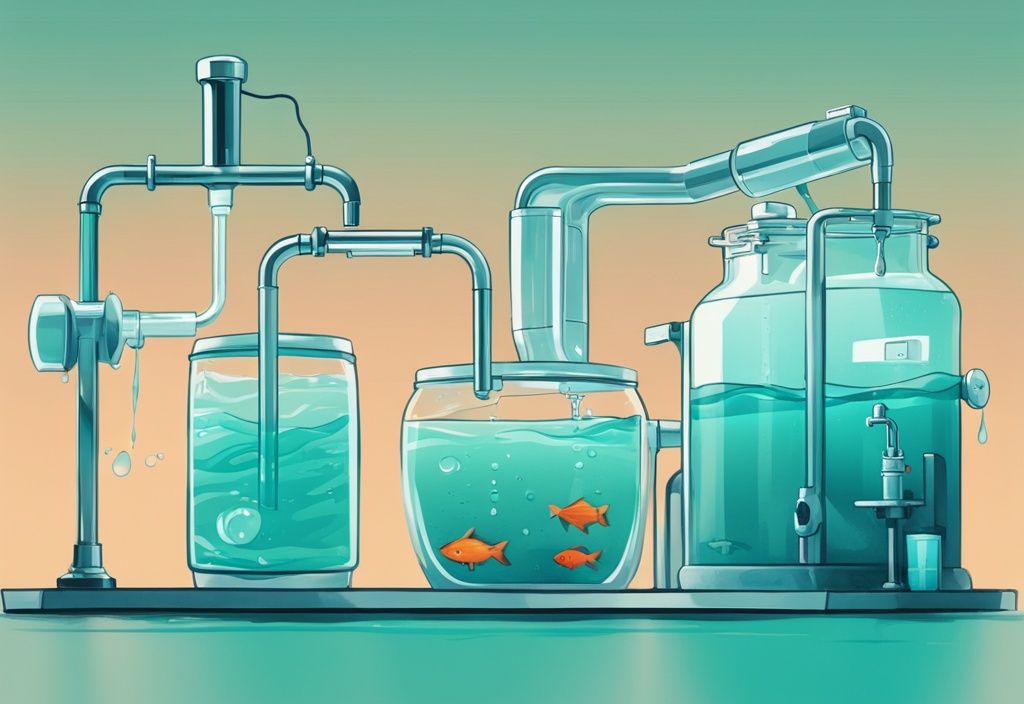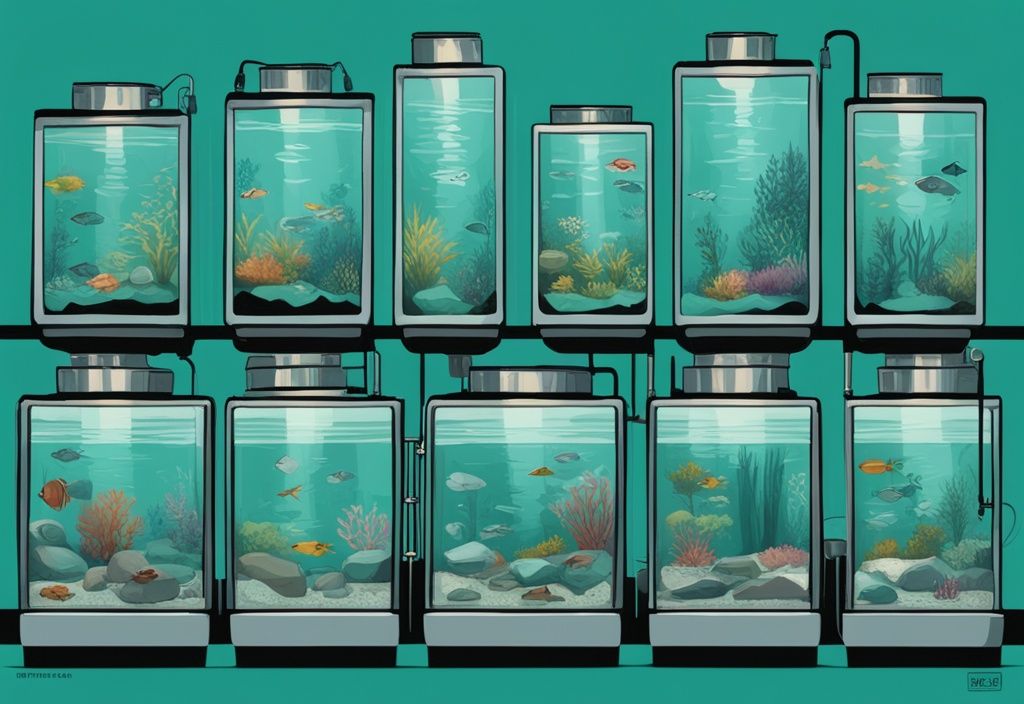Ever wondered, “What kind of water should I use in a fish tank?” Your fish’s survival could hinge on your answer. Just as humans thrive in different climates and conditions, your finned friends also have particular habitat needs. Irrespective of whether you’re a novice aquarist or a seasoned hobbyist, choosing the right water isn’t a matter of preference; but a gamechanger for the health of your aquatic pets.
In this comprehensive guide, you’ll unravel the complexities of different types of water suitable for fish tanks – from necessary parameters like pH, hardness, to temperature. My two decades of marine biology experience has taught me a thing or two about the crucial impact of these often-overlooked water characteristics on the longevity of your fish.
So, let’s dive in together to prevent any stress and illness by ensuring your fish live in the best possible environment.
Understanding the Vital Role of Water in Fish Tank Health
Aquarium enthusiasts must recognize the critical importance of choosing the right kind of water for a fish tank. This decision is foundational for the health and survival of aquatic life.
Not all water is equally suitable for every fish species, and selecting the correct type is pivotal.
Water quality directly influences the well-being and longevity of fish. Poor water conditions can lead to a multitude of issues, including stress, illness, and even death.
Fish depend heavily on specific water parameters such as pH, hardness, and temperature. Maintaining these parameters within ideal ranges is crucial for creating a thriving aquatic environment.
Why All Types of Water Aren’t Suitable for All Fish
Different fish species have unique and specific water parameter needs, which are often determined by their natural habitats. For some fish, soft, acidic water is essential, while others thrive in hard, alkaline conditions. Understanding these requirements is vital to ensure their health and reduce stress.
Using the wrong kind of water for a fish tank can have dire consequences, leading to stress, illness, or even death.
For instance, placing a fish that prefers soft water into a tank with hard water can significantly disrupt its physiological processes.
To replicate the ideal water conditions, one must consider the native habitats of the fish species. By mimicking these natural environments, aquarists can create a balanced ecosystem that supports the health and vitality of their aquatic pets.
Therefore, it is crucial to research and understand what kind of water for a fish tank aligns best with the needs of its inhabitants.
Exploring Different Water Types for Fish Tanks
Unravelling the Good and the Bad of Tap Water
Tap water is a popular choice for many aquarists due to its accessibility and low cost. Generally, tap water is safe to use, but it often contains chlorine and sometimes chloramine, which are harmful to fish. Even with these drawbacks, tap water holds essential minerals beneficial for fish health. However, municipal tap water can occasionally contain ammonia, requiring treatment to ensure your aquatic pets’ wellbeing.
Why Tap Water Needs Dechlorination & How to Do It
Chlorine and chloramine in tap water can be lethal to fish, wiping out beneficial bacteria crucial for a healthy aquarium. To remove these chemicals, use a water conditioner specifically designed for fish tanks. Several methods are available to dechlorinate water: adding a water conditioner, letting the water stand for 24 hours, boiling the water, or solar dechlorination.
Tips for Handling Ammonia in Tap Water
Ammonia is extremely toxic to fish and needs careful handling. Ammonia-removing products or conditioners specifically designed for aquariums can manage ammonia levels effectively. Regular testing of ammonia levels in both tap water and your fish tank is crucial. Performing partial water changes helps dilute ammonia concentration, ensuring a safer environment for your fish.
Well Water: Advantages and Necessary Precautions
Well water, while devoid of chlorine, can vary significantly in its parameters. Often, it has high hardness and low oxygen levels, which may not suit all fish species. Annual testing is essential to ensure well water’s safety for aquarium use. While dechlorination may not be necessary, regularly checking for other contaminants is vital to maintain a healthy aquatic environment.
Assessing the Practicality of Bottled Water in Fish Tanks
Using bottled water in fish tanks can be beneficial as it typically lacks harmful substances. However, it is more expensive and might lack necessary minerals crucial for fish health. Bottled “fish water” from pet stores usually isn’t necessary and can be overpriced compared to other water options.
When and Why to Choose Spring Water Over Distilled Water
For smaller tanks, spring water can be a viable alternative if tap water is unsuitable. Unlike distilled water, spring water contains beneficial minerals that support fish health. While distilled water is pure, it may lead to an imbalanced kH in freshwater tanks but is ideal for saltwater aquariums due to its zero dissolved solids.
The Pros and Cons of Using Reverse Osmosis (RO) Water
RO water is known for its high purity, making it ideal for fish requiring specific water parameters. However, you need to add additives to adjust kH and gH to suit fish tank needs. While purified RO water from an RODI system offers unmatched purity, it might still contain some dissolved solids affecting its suitability for certain fish species.
Adapting RO Water Settings for Fish Tanks
To make RO water suitable for your fish tank, remineralize it by adding elements like calcium, magnesium, and potassium. Consistent monitoring and adjustment of water parameters are essential when using RO water. Understanding your fish species’ specific water requirements is crucial to setting the correct RO water parameters.
Deciphering Optimal Water Parameters for Fish Tanks
To create a flourishing aquarium, it’s essential to understand and maintain the appropriate water parameters. From pH levels to temperature, each factor contributes to a balanced and healthy environment for your aquatic friends.

Essential Water Parameters for Freshwater Tanks
To maintain a thriving freshwater tank, it’s crucial to monitor and regulate key water parameters. These include pH, hardness, KH, and temperature. Each of these parameters plays a unique role in ensuring the health and well-being of your fish, helping to replicate their natural habitats within the confines of a tank.
pH: 6.5-7.5
The pH level of water measures its acidity or alkalinity, a factor that significantly affects fish health and biological processes. For more detailed information on pH levels and their effects, you can visit the EPA’s CADDIS overview. Most freshwater species thrive in water with a pH between 6.5 and 7.5. Maintaining this range helps stabilize the aquatic environment and promotes the biological functions essential for fish survival.
Hardness: Less than 12 dGH
Water hardness, measured in degrees of General Hardness (dGH), is the concentration of dissolved minerals, primarily calcium and magnesium. This aspect is vital for physiological processes such as muscle function and bone development. Freshwater fish generally prefer water hardness lower than 12 dGH. Overly hard or soft water can impact fish metabolism and breeding capabilities.
KH: 4-8 dKH
Carbonate Hardness (KH) indicates the water’s buffering capacity, helping to stabilize pH levels. A KH of 4-8 dKH is ideal for freshwater tanks. Consistently within this range, KH prevents harmful pH fluctuations that could stress or harm your fish. Adequate KH levels also support the beneficial bacteria essential for biological filtration.
Temperature: 68-82°F
The temperature of your aquarium water should align with the specific needs of the fish species you keep. While tropical fish require warmer waters ranging from 75-82°F, cooler water is suitable for temperate species, often falling between 68-75°F. Maintaining an appropriate and stable temperature prevents thermal shock and promotes overall fish health.
Why Consistency in pH Levels Matters
Maintaining consistent pH levels is fundamental for a stable aquatic environment. Sudden pH shifts can cause significant stress to fish, compromising their immune systems and making them susceptible to diseases. Fish are incredibly sensitive to pH changes because such fluctuations can disrupt biological processes and metabolic functions. Consistent pH ensures your fish remain healthy and comfortable in their environment.
Maintaining High Water Quality: A Practical Guide
Understanding and managing what kind of water for a fish tank is appropriate ensure your fish thrive in a balanced ecosystem. This guide explores key practices in maintaining high water quality, from regular water changes to effective testing routines.
Importance of Regular Water Changes & How Often to Do It
Regular water changes are imperative for sustaining a healthy aquarium environment. Fish continuously produce waste, which, if not removed, can build up and create toxic conditions. By performing water changes, you effectively reduce the concentration of harmful substances such as ammonia, nitrites, and nitrates.
The frequency and volume of water changes depend on factors like tank size and bioload. Typically, changing 10-25% of the water weekly is a good practice for most aquariums. Larger tanks with a lower bioload might need less frequent changes, while smaller tanks with more fish should have more regular maintenance. Consistent water changes help in stabilizing critical water parameters, ensuring a safe and stable environment for your aquatic pets.

How to Effectively Test Water Parameters
Monitoring the water quality in your fish tank is essential for early detection of potential issues. Using aquarium water test strips or kits allows you to measure key parameters such as pH, ammonia, nitrites, nitrates, general hardness (GH), and carbonate hardness (KH). Regular testing ensures your tank maintains the optimal conditions for your fish species.
To get accurate readings, follow the instructions on your test kit meticulously. Ideally, water parameters should be tested weekly. If your tank has had recent changes, such as new fish or a change in feeding routines, more frequent testing might be necessary. For more information on water choices, you might wonder, can you use distilled water in a fish tank. Early detection of deviations in water quality will enable you to take corrective actions promptly, preventing problems that could stress or harm your fish.
By understanding and managing what kind of water for a fish tank is appropriate, you can maintain a thriving underwater ecosystem that promotes the health and longevity of your fish. Regular water changes and effective testing routines are key practices every aquarist should master to ensure high water quality and successful fishkeeping.
Mastering Water Conditions Specifically for Your Fish Tank
A Guide to Temperature Regulation
Temperature Regulation Mechanisms:
- For tropical fish, heaters are essential. These devices keep the water temperature consistently warm, usually between 75-80°F. A stable environment mirrors the warmer waters that tropical species are accustomed to.
- Conversely, coldwater species, such as goldfish, thrive in cooler environments. In such cases, you might need to employ coolers to maintain a lower temperature range, generally between 60-70°F.
Monitoring Fluctuations:
- Sudden or drastic temperature changes can lead to significant stress, weakening the immune system of fish and making them susceptible to diseases. Gradual changes are crucial if temperature adjustments are necessary.
- Reliable thermometers are a must to keep an eye on the tank’s temperature. Regular monitoring helps ensure that the temperature remains within the optimal range for the species you are caring for.
Stability and Consistency:
- Consistency in temperature helps maintain a stress-free environment for your fish. Fluctuations should be minimal and gradual to avoid shocking the fish.
- When setting up a new tank or introducing new fish, always match the water temperature in the tank to the temperature from which the fish are being transferred.
Understanding the specific temperature requirements of your fish species and maintaining those conditions is pivotal in creating a thriving aquatic environment. Incorporating the right techniques and tools ensures that the water remains optimal, which is a key aspect of what kind of water for a fish tank you should use.
Avoid Common Mistakes in Choosing Water for Your Fish Tank
Deciding on the right water for your fish tank is vital for ensuring a thriving aquatic environment. Each type of water source presents unique challenges and benefits, and understanding these distinctions can help you avoid common mistakes. Proper water selection and management are foundational to maintaining a balanced and healthy aquarium.
Risks and Precautions When Using Natural Water Sources
Using water from natural sources like lakes or rivers might initially seem like a budget-friendly and convenient option. However, these waters often house harmful bacteria, industrial pollutants, and chemical runoffs that pose significant risks to your fish. Such contaminants can trigger severe and often fatal health problems.
Before even considering natural water, it is crucial to conduct thorough testing and treatment. Utilizing aquarium test kits, check for ammonia, nitrites, nitrates, pH levels, and potential harmful pathogens. Employ robust filtration and purification processes to neutralize detected contaminants. Despite these steps, due to the high potential for unseen pollutants, sticking to safer water sources is generally advisable.

How to Detect Signs of Poor Water Quality
Spotting poor water quality early is essential for your fish’s well-being. Behavioral changes such as lethargy, erratic swimming patterns, or frequent surface gasping are key indicators of bad water conditions. Watch for physical signs too, like clamped fins, discoloration, and visible stress marks.
Regular water testing using reliable aquarium test strips or kits can alert you to problems early on. Key parameters to monitor include pH, ammonia, nitrites, and nitrates. Consistent observation coupled with routine testing helps catch issues promptly, ensuring a healthy aquatic environment. By staying vigilant, you can take swift corrective actions, fostering the well-being and longevity of your fish.
FAQ
What Kind of Water for a Fish Tank
Can I use tap water for my fish tank?
Yes, tap water can be used for your fish tank, but it must be dechlorinated. Tap water often contains chlorine and other chemicals that are harmful to fish. Moreover, it’s crucial to treat it for ammonia and other contaminants ensuring the water is safe for your aquatic friends.
How do I remove chlorine from tap water?
You’ve got several options to remove chlorine from tap water:
- Water conditioners: These are available in pet stores and make the process quick and efficient.
- Letting the water stand: Allow the water to sit for 24 hours to let the chlorine dissipate naturally.
- Boiling: Boil the water and let it cool. This method evaporates chlorine gases.
- Solar dechlorination: Expose the water to direct sunlight, which helps break down chlorine over time.
Each of these methods contributes to making tap water safe for your fish.
Is bottled water better for fish tanks?
Bottled water might seem like a safer option as it’s often free from harmful substances. However, it usually lacks the essential minerals that fish need. Spring water is a better choice over distilled water since it contains these beneficial minerals. Note, though, that bottled water tends to be more expensive.
What is the optimal water temperature for fish tanks?
The optimal water temperature for fish tanks varies:
- Freshwater tanks: Typically should be between 68-82°F, depending on the species.
- Saltwater tanks: Generally need a temperature range of 75-79°F to maintain a healthy environment.
Maintaining the right temperature is vital for the health and well-being of your fish.
Can I use distilled water for my freshwater fish tank?
Using distilled water is not ideal for freshwater tanks as it lacks essential buffers. If you decide to use distilled water, make sure to remineralize it to achieve suitable water chemistry. This adjustment will help support fish health and stability by providing the necessary minerals that distilled water alone does not offer. If you’re wondering why your fish tank might have an unpleasant odor, you can read more about it in our article on why does my fish tank smell.
Conclusion
Establishing a thriving fish tank is more than just about choosing beautiful fish; it requires in-depth research and attention to detail, especially when considering what kind of water for a fish tank will best support your aquatic pets. Different fish species have unique water parameter requirements, and understanding these needs is vital for their health and longevity.
First and foremost, take time to research the specific water needs of each fish species you plan to keep. This means paying attention to pH levels, water hardness, and temperature requirements that mimic their natural habitats. For instance, species from soft, acidic waters will not thrive in hard, alkaline conditions and vice versa. This foundational step is crucial for setting up a stable and suitable environment for your fish.
Regular monitoring and maintenance of water quality cannot be understated. Consistently test for key parameters such as pH, ammonia, nitrites, nitrates, and overall hardness. Water quality is the cornerstone of a healthy aquarium, and neglecting this aspect can lead to stressed, unhealthy, or even dead fish. Employing reliable test kits and maintaining a log of your water parameters will help you detect and address any deviations early, ensuring a stable environment.
Utilizing the correct type of water is another critical element. Whether you opt for tap water, well water, bottled water, or reverse osmosis water, each type has its pros and cons that must be managed appropriately. For example, tap water may need dechlorination and ammonia treatment, while well water requires testing for contaminants. Distilled water, on the other hand, lacks the minerals necessary for fish health and must be remineralized, while reverse osmosis water necessitates careful parameter adjustments.
Maintaining optimal water parameters is key to promoting the wellbeing of your fish. Regularly performing partial water changes, using water conditioners when necessary, and ensuring proper filtration will go a long way in sustaining a balanced aquatic environment. Remember, a stable aquarium with minimal fluctuations in water parameters not only supports the health and longevity of your fish but also enhances their vibrant colors and natural behaviors.
By approaching the setup and maintenance of your fish tank thoughtfully, particularly regarding the kind of water for a fish tank, you’ll create a thriving underwater world that delights both you and your aquatic residents.
